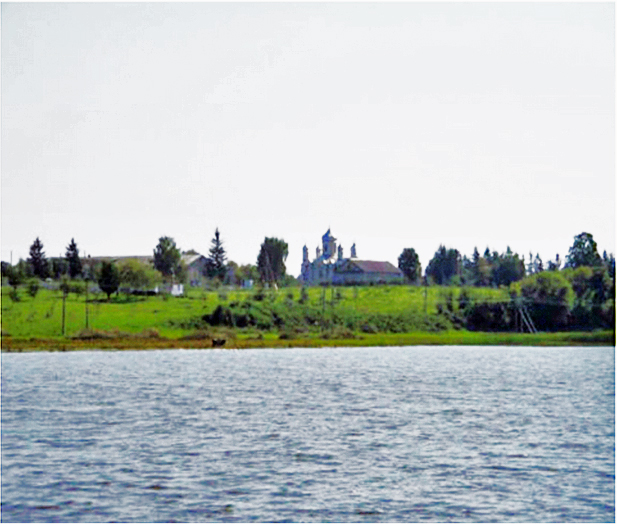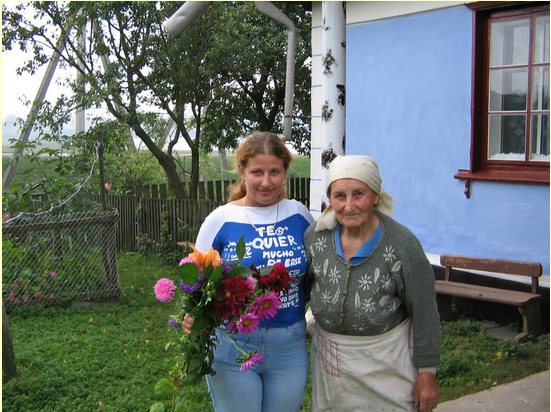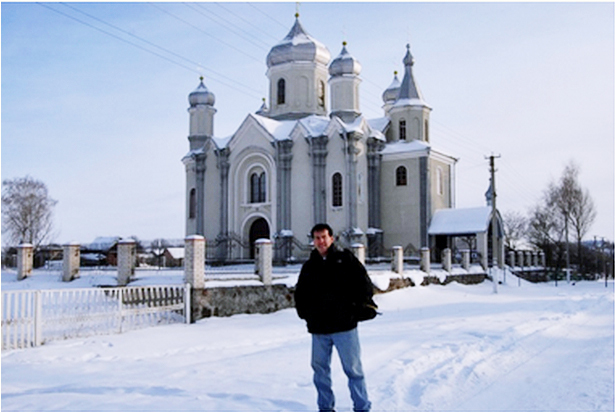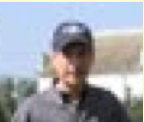

Contents
CLICK ON ITEM TO DISPLAY
Impressions During a Visit, by David Winer
Impressions of Kulchiny, by Herbert Bixhorn
Yevginia's Recollections of Kulchiny, by Dave Winer
Monuments at Kulchiny, by Nikolay Pekarskiy
Manevtsy Memorial Restoration Project, By Nikolay Pekarskiy
Manevtsy Memorial Site Restored, by Nikolay Pekarskiy
Impressions During a Visit to Kulchiny
by David Winer - July 2011
In 1910, as a 20 year old, my grandfather, Pinchas (Benjamin) Winer, left Kulchiny to New York City. It was before World War One and the Russian Revolution. Kulchiny (known then as Kolczyn in Polish) was tucked away amongst the expansive rolling wheat fields of Ukraine. It was isolated and accessible, even today, only by an unpaved dirt road. The Shtet’s isolation kept its Jewish inhabitants closely bound together for survival in a hostile gentile environment. Most of Kulchiny's Jews were small-scale traders, craftsmen or artisans and their thriving local market was the envy of the local villages. The last census taken in 1897 stated there were 2031 Jews, comprising 47% of the population.
What were my grandfather’s thoughts as he sat alone and watched his family, home and village slowly fade away in the distance as the horse drawn wagon bumped along the dirt road. I will never know. But, he would never have imagined that his grandson David would return 101 years later to see the fate of his Kulchiny.
Prior to my trip in July 2011, I conducted an exhaustive search on the internet and visited two Jewish libraries I was unable to locate any background or historical information. There was no written history in the Landshaftsman archive and no Yizkor book was wrote. Perhaps Kulchiny was just too small and remote to garner any interest.
In July 2011, I stayed overnight in the town or Krasilov and that morning was met at the hotel by Dymtro Severnuik, a squat, strong and animated man with a broad slavic smile and boundless energy. He is the local Kulchiny history teacher and wrote a book about the history of Kulchiny. He was inspiring in his vigor and interest in us, the Jewish descendants of Kulchiny. (Herb Bixhorn and Joey Resnick had earlier met Dymto during their visit in 2005 & 2010). I think Dymtro realizes that the loss of the Jews set Kulchiny back decades, even centuries.
On the ride to Kulchiny, likely on same dirt road my grandfather took 101 years before, Dmytro explained that the center of Kulchiny was totally Jewish. The area of the ghetto was the main Jewish
residential and market area and is now an empty field, a wide boulevard with a 1960’s era elementary school. Dymtro gave us a tour of the village and its nothingness; the two Jewish cemeteries, now just empty fields with no tombstones, the synagogue site is now a wooded area, the market area is an open field and apple trees have been planted in the residential area.
In the village there is a monuments for the 1932 famine and the political repression by the Communist Soviet regime, but no mention of the Jews, their existence or plight. In the neighboring village of Manivsti there is a Russian built monument at the killing site remembering the victims of “fascism”
Of the hundreds years of Jewish life there are two homes still standing, unoccupied. One owned by the Gingold family and another a classic low roofed Shtel home painted blue. Alongside a dirt road, one tombstone lies face down half buried in the dirt. It was not located in either of the cemetery’s and was likely being transported and fell off the wagon and simply left there. It is not possible to read any inscription as only the back of it remains aboveground. There is a boarded up Polish Catholic church and one rebuilt Orthodox church that is currently in use. There are currently 900-1000 inhabitants, less than the pre-war population. There are no stores or markets and is totally rural with most homes using out-houses without running water. Cows, chickens, ducks and other animals roam lazily amongst the streets and horse drawn carts are the preferred mode of local transportation.
Traveling in rural Ukraine can be challenging. Before arriving in Kiev, I had hired a driver and a young Jewish guide, Margarita Lopatina. Travel here requires a driver and guide as there are few road signs or gas stations. After spending the night in Krasilov, we drove to Kulchiny for 30 minutes on a dirt road through rolling hills covered with wheat. We came upon Kulchiny, a village literally right in the middle of fields, with a large lake/pond surrounded by small wooden homes. There were no cars; horses pulled wheat and other carts along the main road.
The old Jewish section of town was in the prime area of Kulchiny, as it sat along the water. The area of the destroyed synagogue is wooded now and on a small rise. Our driver Dmytro told us that for years people came with metal
detectors looking for the “Jewish gold’ they imagined was buried during the Nazi occupation. In one area, all the Jewish homes once stood is now covered
with planted apple trees. He insisted that I look carefully at the ground to see the depressions of the homes’ foundations.
The following are comments of Yevgenia is a resident of present-day Kulchiny made during my visit to Kulchiny in July 2011.
There are no stores, markets or any Jewish religious buildings. There are just two homes still standing that were owned by Jews. One was owned by the Gingold family. There were two Jewish cemeteries that are now gone. The old cemetery Is located about ½ kilometer outside the town on a rise and is now a field planted with crops and the other is on the edge of Kulchiny on a very small hill. One tombstone remains and lies face down half buried in the dirt. It is not possible to read any inscription as only the back of it remains above ground. There is no marker, memorial or any indication of the Jewish presence there. There is a boarded up Polish Catholic church and one rebuilt Orthodox

Margartia Lopatina and Yefegnia Babich
* * *
Impressions During a Visit To Kulchin
September 20, 2005
by Herb Bixhorn
Kulchiny is a village of 1,100 people. It was our unbelievable good luck to find in this tiny village a history teacher who has written a book on the history of Kulchiny from medieval times up to World War I. When we arrived in Kulchiny, we asked some children if there was anyone in the village who knew the history of the area. They lead us to their school, where we were introduced to Dmytro Severenyuk, a history teacher. Dmytro immediately asked if I were Jewish, and when I answered “yes”, he broke into a smile, became very animated, and said “You know, this was a Jewish village”. He showed me a copy of this book which is written in Ukrainian. I randomly flipped through the pages, which are full of statistics, and there on page 101 I saw the name of my great-grandfather, Yankel Leibovitch Bixgorin, listed as one of 34 grocery store owners in Kulchiny and the surrounding region. Dmytro told us that Kulchiny had been an entirely Jewish village with Ukrainians living on the outskirts. The village was completely destroyed in World War II; there is no trace of it. The place where the village stood is now called the village center. This is a pitiful looking area with an abandoned building, another building with a small shop, empty fields, and a school. The homes of present-day Kulchiny are on the edge of what had been the Jewish village.
Dmytro took us to his home and gave me a copy of his book and signed it “To all Jews from Kulchiny who live in America, especially the Bixgorin family”. He then lead us to a small hill where the Jewish cemetery had been. There was nothing there, only a pasture. Then he took us to a wooded area where there had been a synagogue. Again, nothing there. Dmytro told us they found a tunnel that lead from the synagogue to the lake. This apparently was a way for Jews to escape during pogroms.
Dmytro then took us to the home of Yevgenia Babich, an 82 year old woman who had had Jewish friends before the war. Yevgenia was working in her garden (a mini-farm) when we arrived. She was eager to talk to us. She said that she had so many stories to tell, and no one to tell them to. She never expected someone to come from America anxious to hear these stories.
Dmytro had said the same thing. He had made only 10 copies of his book and never expected anyone to be interested in them. Yevgenia said that aside from owning shops, Jews were skilled workers who produced clothing and shoes, and had pharmacies. On market days the village was full of activity with people coming from distant places to buy and sell. Yevgenia’s father worked with Jews in shoe manufacture and could speak Yiddish. (My father had told me that he knew Ukrainians who could speak Yiddish as well as Jews.) She mentioned the names of Jewish families she had been friends with, and said that some of her Ukrainian neighbors were envious and angry with her because of these friendships. Now Kulchiny has none of the activity of the past. It is made up entirely of farmers who work their fields outside the village.
* * *
Excerpts from an interview with Yefgenia Babich
Prepared following a visit by David J. Winer, July 2011
Yefgenia is an elderly resident of Kulchiny
After WWII, Kulchiny was more than half empty. Many letters arrived in Kulchin from places outside of Ukraine asking if anyone had survived the war, asking what happened to
the Jews. Yefgenia thinks that 100% of the Jews living in Kulchiny were killed and, if there were survivors, non ever returned. She remembered the Jewish family names of Shuster, Schreibman, Katz and Fuchs.
During the war, the Jewish homes and religious buildings were taken apart, All that remains of the Jewish neighborhoods are two Jewish homes, one that had been owned by the Gingold family and the other typical small shtetl home whose residents are unknown.
There was an underground tunnel for hiding during the Pogroms under the old synagogue. After the war and for many decades later, young people would dig around the grounds where the synagogue and the Jewish neighborhood had been, looking for buried gold. Currently, the population of Kulchiny is smaller than it was before the war and no Jew lives there.
For information on Yefgenia's thoughts about pre-WWII Kulchiny, go to the section on Kulchiny History.

Joe Resnick in front of the new Kulchiny Orthodox Church
* * *
From a chat with Yefgenia Babich
By Herb Bixhorn

Kulchiny now has none of the activity of the past. It is made up entirely of farmers who work their fields outside the village.

The center of present-day Kulchiny, with a horse-drawn cart, the favorite mode of transportaion.
Copyright © 2012 David Winer